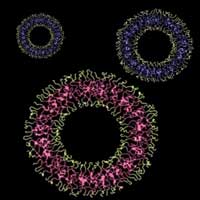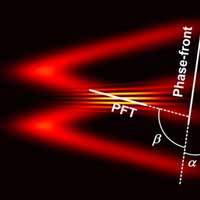 Researchers have fabricated ultrathin, flexible, transparent sensors with cross-aligned silver nanowire microelectrodes fabricated using print technique that are scalable and require minimal raw materials.
Researchers have fabricated ultrathin, flexible, transparent sensors with cross-aligned silver nanowire microelectrodes fabricated using print technique that are scalable and require minimal raw materials.
Monday, December 14, 2020
Toward imperceptible electronics that you cannot see or feel
 Researchers have fabricated ultrathin, flexible, transparent sensors with cross-aligned silver nanowire microelectrodes fabricated using print technique that are scalable and require minimal raw materials.
Researchers have fabricated ultrathin, flexible, transparent sensors with cross-aligned silver nanowire microelectrodes fabricated using print technique that are scalable and require minimal raw materials.
Industrial waste is reused to produce alternatives to plastic
 Researchers reused bacterial cellulose scraps usually thrown away by manufacturers of wound dressings to make strong biodegradable film for food packaging.
Researchers reused bacterial cellulose scraps usually thrown away by manufacturers of wound dressings to make strong biodegradable film for food packaging.
Reducing pesticide use with nanoparticles
 Scientists have discovered how certain silica nanoparticles could act as a traceless, degradable, and highly efficient treatment against some plant pathogens.
Scientists have discovered how certain silica nanoparticles could act as a traceless, degradable, and highly efficient treatment against some plant pathogens.
When less is more: A single layer of atoms boosts the nonlinear generation of light
 Researchers show that structures built around a single layer of graphene allow for strong optical nonlinearities that can convert light.
Researchers show that structures built around a single layer of graphene allow for strong optical nonlinearities that can convert light.
Physics discovery leads to ballistic optical materials
 Scientists have found a way to create more efficient metamaterials using semiconductors and a novel aspect of physics that amplifies the activity of electrons.
Scientists have found a way to create more efficient metamaterials using semiconductors and a novel aspect of physics that amplifies the activity of electrons.
Researchers investigate photosensitive carbon nanoparticles
 Researchers have managed to identify the fundamental problems relating to the photophysics and photochemistry of carbon nanocolloids, and ascertain possible approaches for research into these readily available, non-toxic and adaptable nanomaterials.
Researchers have managed to identify the fundamental problems relating to the photophysics and photochemistry of carbon nanocolloids, and ascertain possible approaches for research into these readily available, non-toxic and adaptable nanomaterials.
'Magic' angle graphene and the creation of unexpected topological quantum states
 Electrons inhabit a strange and topsy-turvy world. These infinitesimally small particles have never ceased to amaze and mystify despite the more than a century that scientists have studied them. Now, in an even more amazing twist, physicists have discovered that, under certain conditions, interacting electrons can create what are called 'topological quantum states'.
Electrons inhabit a strange and topsy-turvy world. These infinitesimally small particles have never ceased to amaze and mystify despite the more than a century that scientists have studied them. Now, in an even more amazing twist, physicists have discovered that, under certain conditions, interacting electrons can create what are called 'topological quantum states'.
Bacterial nanopores open the future of data storage
 Bioengineers have developed a nanopore-based system that can read data encoded into synthetic macromolecules with higher accuracy and resolution than similar methods on the market. The system is also potentially cheaper and longer-lasting, and overcomes limitations that prevent us from moving away from conventional data storage devices that are rapidly maxing out in capacity and endurance.
Bioengineers have developed a nanopore-based system that can read data encoded into synthetic macromolecules with higher accuracy and resolution than similar methods on the market. The system is also potentially cheaper and longer-lasting, and overcomes limitations that prevent us from moving away from conventional data storage devices that are rapidly maxing out in capacity and endurance.
Using crab shells to improve palladium catalyst nanoparticles
 Chemists synthesized soluble biopolymers based on chitin from crab shells. Together with palladium, they form effective catalysts for organic reactions, and their nanoparticles can be re-used over ten times.
Chemists synthesized soluble biopolymers based on chitin from crab shells. Together with palladium, they form effective catalysts for organic reactions, and their nanoparticles can be re-used over ten times.
Nanoparticles, from hype to actual clinical product
 Scientists investigated a robust and scalable manufacturing process for nanocarriers and their building blocks. With these insights, the road to widely available clinical applications for nanocarriers has become much shorter.
Scientists investigated a robust and scalable manufacturing process for nanocarriers and their building blocks. With these insights, the road to widely available clinical applications for nanocarriers has become much shorter.
Sheets of carbon nanotubes come in a rainbow of colours
 Nanomaterials researchers have created a colour atlas for 466 unique varieties of single-walled carbon nanotubes.
Nanomaterials researchers have created a colour atlas for 466 unique varieties of single-walled carbon nanotubes.
Not so fast! Controlling the speed of light bullets
 Researchers have accurately and arbitrarily control flying velocities of light bullets, offering new opportunities for optical and physical applications.
Researchers have accurately and arbitrarily control flying velocities of light bullets, offering new opportunities for optical and physical applications.
Looking inside the glass
 Scientists study aluminosilicate glass to determine its complex local structure with unprecedented detail. This work may lead to tougher and more inexpensive glass for touchscreens and solar arrays.
Scientists study aluminosilicate glass to determine its complex local structure with unprecedented detail. This work may lead to tougher and more inexpensive glass for touchscreens and solar arrays.
Artificial Chemist 2.0: Custom quantum dots in less than an hour
 A new technology, called Artificial Chemist 2.0, allows users to go from requesting a custom quantum dot to completing the relevant R+D and beginning manufacturing in less than an hour. The tech is completely autonomous, and uses artificial intelligence (AI) and automated robotic systems to perform multi-step chemical synthesis and analysis.
A new technology, called Artificial Chemist 2.0, allows users to go from requesting a custom quantum dot to completing the relevant R+D and beginning manufacturing in less than an hour. The tech is completely autonomous, and uses artificial intelligence (AI) and automated robotic systems to perform multi-step chemical synthesis and analysis.
Subscribe to:
Comments (Atom)
